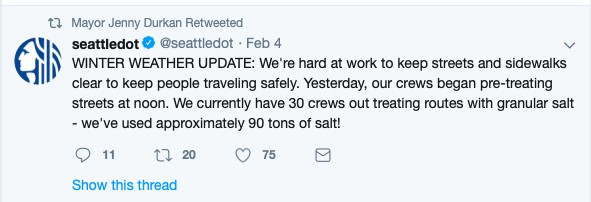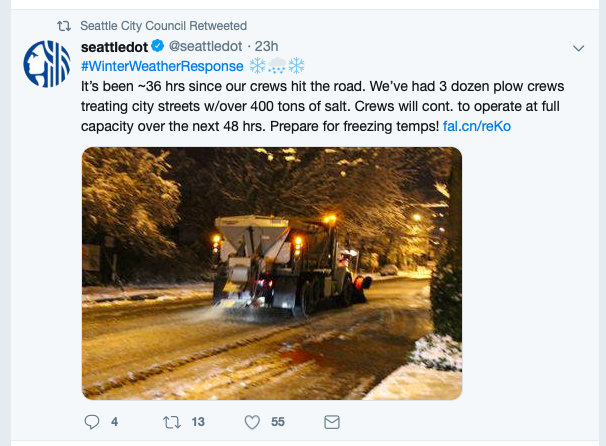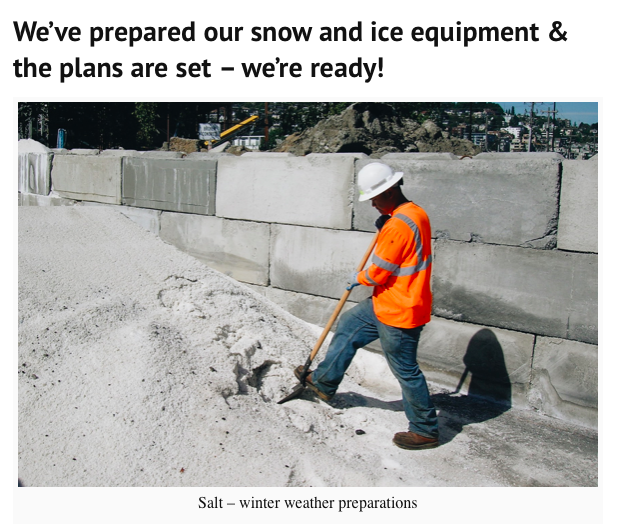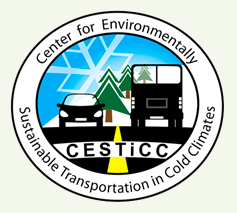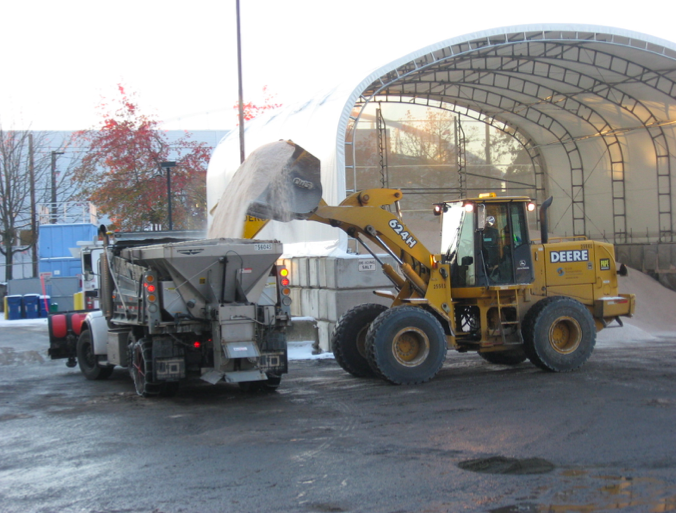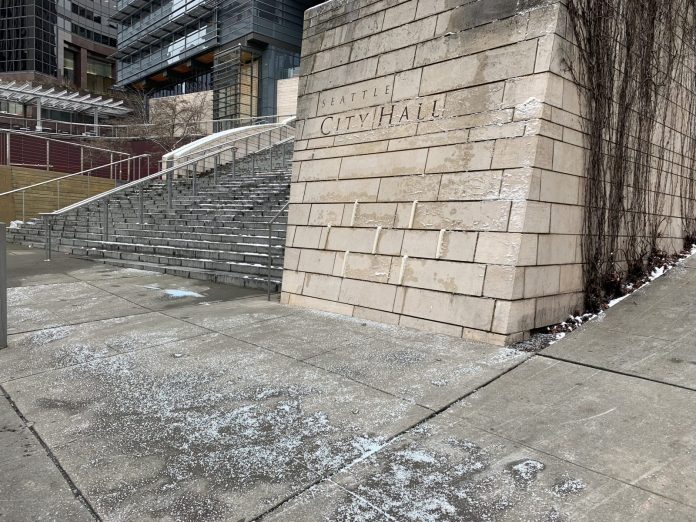
Treating roads with salt has many negative environmental impacts. Why are SDOT and the City of Seattle so proud of how much salt is being dumped on Seattle’s roads?
Seattle’s recent cold snap has made roads and sidewalks icy and dangerous. As a former Midwesterner who has never mastered the art of walking across icy pavement unscathed, I’m deeply sympathetic toward the City of Seattle and Seattle Department of Transportation’s (SDOT) mission to create safe winter travel conditions for all travelers.
But, an obsession with salt, specifically with how many tons of salt are being dumped on Seattle’s roads, caught my attention as I read through SDOT’s recent blog posts and tweets, which importantly have been retweeted by the Mayor and City Council.
The amount of salt quickly increased as the hours went by. What was once 90 tons of salt quickly became 900 tons.
New drivers are on the road to continue treating and plowing all routes through the night with a newly replenished supply of 500+ tons of salt for our 35+ plows. Drivers from Seattle Public Utilities and Seattle Parks and Recreation have partnered with us to help in this great effort.
For each 12-hour shift, there is 50-60 staff who have so far treated our surface streets with approximately 400 tons of salt. In addition, we have 15-30 hand crews clearing curb ramps for pedestrians
SDOT Blog, February 4th, 2019
900 tons is a lot of salt. However, this figure alone is not too surprising. Salt for winter road treatments is a multi-billion dollar industry that results in roughly 22 million tons of salt scattered on U.S. roads annually, about 137 pounds of salt for every American.
What is surprising is how excited SDOT is about dumping all this salt. SDOT really wants Seattleites to know they use, to quote a 2016 SDOT blog post,“a lot (lot) of salt.” Given the retweets by the Mayor and City Council, it appears they also want Seattleites to be in the know about all this salt as well.
SDOT’s Problematic Love Affair With Salt
SDOT’s love affair with salt is surprising for a few reasons. For one, salt is known to have serious, negative effects on the environment. After its application to pavement, salt breaks down into sodium and chloride, each of which can pose threats to humans, pets, wildlife, and ecosystems.
Chloride is especially problematic because it is not biodegradable and accumulates in vegetation, soil, surface water, ground water, and the air. Chloride is toxic to aquatic life. Even low concentrations can produce harmful effects in freshwater ecosystems.
As a result, decreasing or even removing salt from winter road treatments has become a significant environmental issue. Cities as large as New York City and small as Olympia, are seeking out more environmentally friendly solutions.
Washington State University (WSU) is even considered to be a pioneer in this realm. Along with University of Alaska Fairbanks and Montana State University, WSU created the Center for Environmentally Sustainable Transportation in Cold Climates (CESTiCC), which explores various methods for minimizing the environmental damage of controlling ice on roads.
Greener Alternatives to Salt Exist
“We are kind of salt addicted, like with petroleum, as it’s been so cheap and convenient for the last 50 years,” said Xianming Shi, a WSU associate professor in civil and environmental engineering in an article with WSU Insider about the CESTiCCs work to devise greener methods for de-icing roads.
Deicers made from beet and tomato juice, as well as leftover barley residue from vodka distilleries, molasses, and even cheese brine, have all proven effective for ice-removal, although no single solution is perfect. Some solutions are more effective than others and all have a certain level of environmental impact.
Professor Shi is also exploring how to create ice-free pavement by adding nano- and micro-sized particles to concrete that make it less prone to icing over. The particles create a surface barrier that prevents the mixture from bonding with snow and ice. The result is easier snow removal and less need for salt.
While installing ice-free pavement might be worth it in Eastern Washington cities like Pullman and Spokane, it is unlikely that temperate Seattle would make such an investment.
However, budget-friendly alternatives also exist. The use of salt brine, or a saltwater mixture, has become commonplace and is considered to be a greener alternative to applying salt to roads. SDOT pretreats roads with salt brine. So why doesn’t the agency highlight its more environmentally safe practices, rather than drawing the public’s attention to how much salt it is dumping on roads?
The Great Seattle Salt Debate of 2008
A decade ago, salt was banned from Seattle’s roads because of concerns over its negative environmental impact, in particular its harmful effects on freshwater creeks and rivers that serve as salmon habitat. The City of Seattle and SDOT used sand instead of salt.
Then came the Seattle Snow Catastrophe of 2008.
The city received its heaviest snowfall in a decade and found itself underprepared for snow removal efforts. In addition to widespread traffic gridlock, the fact that two charter buses carrying students slid through a barrier on Capitol Hill and almost crashed onto I-5, made many Seattleites very, very angry.
As a result, Seattle “reversed its course” and officially changed its policies regarding salt. Whereas previously it applied sand to roads, now it would use salt. The Seattle Times even hailed the change as more environmentally friendly, although others would disagree.
However, the change came too late for then Mayor Greg Nickels, who was widely criticized, and even dubbed “Salt Nick,” because of what was seen as his refusal to use salt on Seattle roads. Nickel’s defeat in the mayoral primary the following year was even attributed in part to public anger over the City’s poor response to the snowstorm.
Salt then became a political issue in Seattle. Being associated with “wimpy” snow and ice removal methods, like using sand instead of salt, became a political liability. Hence, the retweets of SDOT’s ecstatic salt use by both the Mayor and City Council.
This positive attitude toward dumping (literally) tons of salt is deeply problematic. It completely avoids the negative impacts of salt and reinforces to the public the idea that applying a lot of salt to roads and sidewalks is a good thing when it absolutely is not.
What would be more important to state is that for sidewalks and private driveways, a lot of environmentally-friendly alternatives exist. Sugar beet juice, alfalfa meal, and even coffee grounds, are cheap, easy to obtain, and effective for smaller-scale use.
Yes, on a municipal level it will probably be necessary to continue to use salt on roads in the near future. However, alternatives to salt are improving in safety, cost, and environmental sustainability. The City of Seattle and SDOT should commit to making improvements in these areas and only use as much salt as is absolutely necessary. It’s time to stop being proud of how many hundreds or thousands of tons of salt are being dumped into our environment.
Natalie Bicknell Argerious (she/her) is a reporter and podcast host at The Urbanist. She previously served as managing editor. A passionate urban explorer since childhood, she loves learning how to make cities more inclusive, vibrant, and environmentally resilient. You can often find her wandering around Seattle's Central District and Capitol Hill with her dogs and cat. Email her at natalie [at] theurbanist [dot] org.


